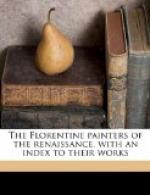VIII.
[Page heading: REPRESENTATION OF MOVEMENT]
Turning our attention first to movement—which, by the way, is not the same as motion, mere change of place—we find that we realise it just as we realise objects, by the stimulation of our tactile imagination, only that here touch retires to a second place before the muscular feelings of varying pressure and strain. I see (to take an example) two men wrestling, but unless my retinal impressions are immediately translated into images of strain and pressure in my muscles, of resistance to my weight, of touch all over my body, it means nothing to me in terms of vivid experience—not more, perhaps, than if I heard some one say “Two men are wrestling.” Although a wrestling match may, in fact, contain many genuinely artistic elements, our enjoyment of it can never be quite artistic; we are prevented from completely realising it not only by our dramatic interest in the game, but also, granting the possibility of being devoid of dramatic interest, by the succession of movements being too rapid for us to realise each completely, and too fatiguing, even if realisable. Now if a way could be found of conveying to us the realisation of movement without the confusion and the fatigue of the actuality, we should be getting out of the wrestlers more than they themselves can give us—the heightening of vitality which comes to us whenever we keenly realise life, such as the actuality itself would give us, plus the greater effectiveness of the heightening brought about by the clearer, intenser, and less fatiguing realisation. This is precisely what the artist who succeeds in representing movement achieves: making us realise it as we never can actually, he gives us a heightened sense of capacity,




